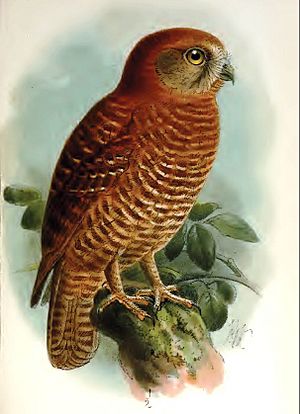Christmas boobook facts for kids
Quick facts for kids Christmas boobook |
|
|---|---|
 |
|
| Illustration by Keulemans, 1900 | |
| Conservation status | |
| Scientific classification | |
| Genus: |
Ninox
|
| Species: |
natalis
|
| Synonyms | |
|
|
The Christmas boobook (Ninox natalis) is a type of owl. It is also known as the Christmas Island hawk-owl. This bird belongs to the owl family called Strigidae.
This owl is closely related to other hawk owls found in Southeast Asia and Australia. A scientist named J.J. Lister first classified it as its own species in 1888. Later, in 1998, DNA tests confirmed that it is indeed a unique species of owl.
Contents
Where Does the Christmas Boobook Live?
The Christmas boobook lives only on Christmas Island. This is a small Australian territory in the Indian Ocean. The island is about 135 square kilometers (52 square miles) in size. It is located about 360 kilometers (224 miles) south of Java.
The plants and animals on Christmas Island are in danger. This is due to human activities and new species brought to the island. Because the Christmas boobook lives in such a small area, it is listed as a vulnerable animal. This means it could become endangered if threats continue. The IUCN keeps track of its status.
People have been mining for phosphate on the island for over 100 years. Also, new buildings for immigration have been built. These activities increase the impact from humans. However, the Australian National Parks and Wildlife Service manages 64% of the island as a national park. This helps protect the wildlife.
What Does the Christmas Boobook Look Like?
The Christmas Island hawk-owl is a small bird. It has reddish-brown feathers and a striped chest. Its face is dark chestnut, with a whitish area above its eyes, on its cheeks, and throat. It has bright yellow eyes, legs, and feet.
These owls are about 26–29 centimeters (10–11 inches) long. They weigh between 130 and 190 grams (4.6–6.7 ounces). Female owls are usually a bit larger than males.
Their call sounds like a double hoot, "boo-book." It has a clucking sound, and the second note is usually lower. Young owls make a high-pitched trill when they want food.
Their calls are similar to the Australian boobook. Each owl's call is a little different. This can help scientists count the owls. It is sometimes hard to track them in certain areas.
Where Do Christmas Boobooks Live on the Island?
The Christmas boobook's natural habitats are wet lowland forests. They also live in moist shrubland areas.
These owls have their own territories and are found all over the island. They use both natural forests and areas that have been changed by humans. However, fewer owls are found in areas where new plants are growing back. In 1995, there were about 560 breeding pairs. By 2004, the population was estimated to be around 1,000 birds. A more recent estimate from 2011 suggests the population might be even lower.
They like to rest in places that are hidden and safe. They often choose trees with thick tops and medium-level bushes below. This allows them to escape easily if needed.
They build their nests in tree hollows. These are usually found in the tops of trees like Planchonella nitida, Hernandia ovigera, and Syzygium nervosum.
What Do Christmas Boobooks Eat?
Christmas boobooks mainly eat insects. They enjoy medium to large insects like beetles and tree crickets. They also eat moths and introduced cockroaches.
Sometimes, they also eat small animals with backbones. These include the Christmas Island white-eye bird and geckos. They even eat introduced house geckos and black rats.
What Threats Do They Face?
The Christmas boobook faces many dangers. One major threat is habitat destruction caused by humans. Also, new species brought to the island cause problems. These include the yellow crazy ant, cats, and black rats. These new species harm both the owls' habitat and other native wildlife.
The yellow crazy ant is an invasive species. It causes problems in many ways. Most importantly, these ants kill off the island's keystone species, the red crab (Gecarcoidea natalis). The red crabs are very important for the forest. When they are gone, the forest changes a lot. Also, the ants help other insects that damage the tree canopy.
Scientists think that yellow crazy ants might also eat young owl chicks in their nests.
While most mining has stopped, there are ongoing programs. These programs monitor and control the introduced species. This helps protect the Christmas boobook and its home.
See also
 In Spanish: Nínox de la isla de Navidad para niños
In Spanish: Nínox de la isla de Navidad para niños


